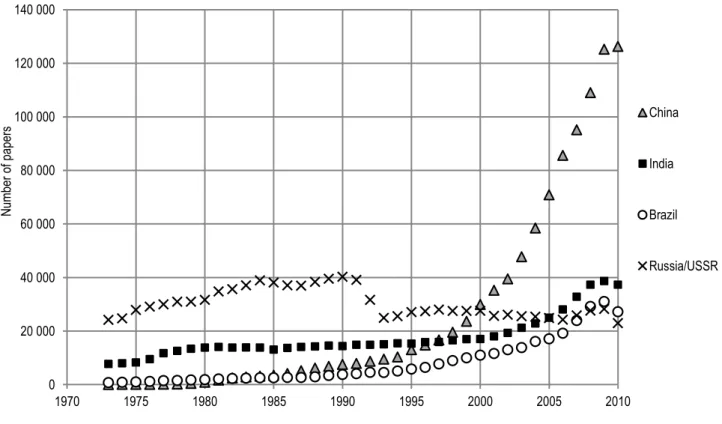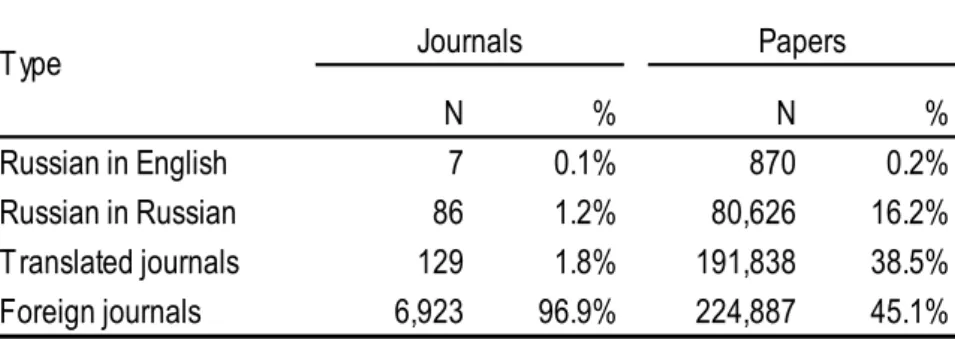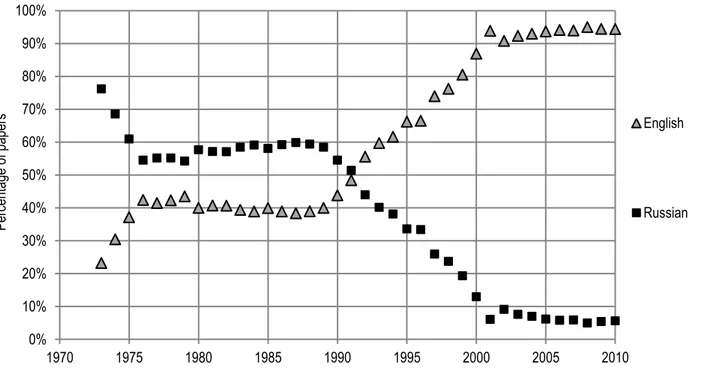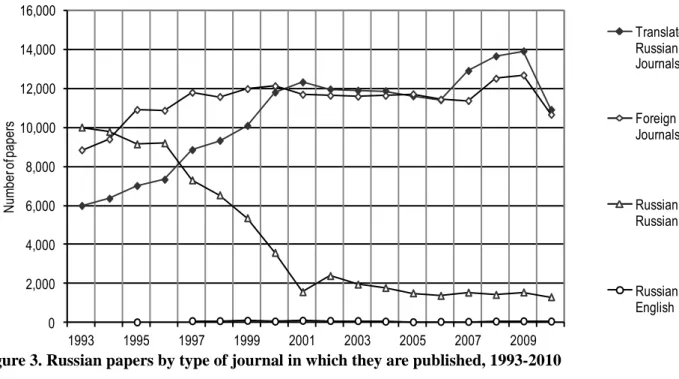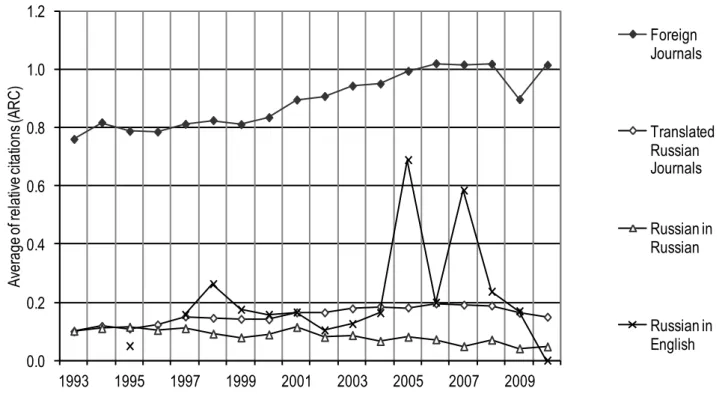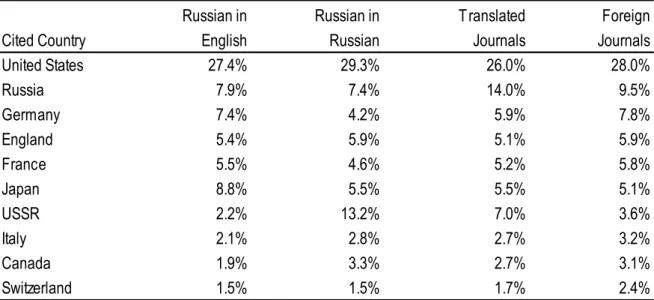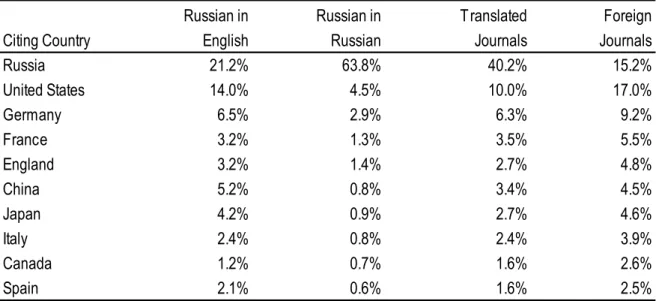Changes in publication languages and citation practices and their effect on the scientific impact of Russian Science (1993-2010)1
Olessia Kirchik1, Yves Gingras2, Vincent Larivière2,3
1
Laboratory for S&T studies, National Research University Higher School of Economics, Myasnitskaya str., 18, Moscow, 101000, Russian Federation.
2
Observatoire des sciences et des technologies (OST), Centre interuniversitaire de recherche sur la science et la technologie (CIRST), Université du Québec à Montréal, CP 8888, Succ. Centre-Ville, Montréal, QC. H3C 3P8, Canada
3
École de bibliothéconomie et des sciences de l'information, Université de Montréal, C.P. 6128, Succ. Centre-Ville, Montréal, QC. H3C 3J7, Canada
[okirchik@hse.ru; gingras.yves@uqam.ca; vincent.lariviere@umontreal.ca]
Abstract
This paper analyses the effects of publication language on international scientific visibility of Russia using the Web of Science. Like other developing and transition countries, it is subject to a growing pressure to “internationalize” its scientific activities, which primarily means a shift to English as a language of scientific communication. But to what extent does the transition to English effectively improve the impact of research? The case of Russia is of interest in this respect as the existence of many combinations of national journals and languages of publications (namely Russian and English, including translated journals) provides a kind of natural experiment to test the effects of language and of publisher's country on the international visibility of research through citations as well as on the referencing practices of authors. Our analysis points to the conclusion that the production of original English-language papers in foreign journals is a more efficient strategy of internationalization than the mere translation of domestic journals. Still, if the objective of a country is to maximize the international visibility of its scientific work, then the efforts should go into the promotion of publication in reputed English language journals in order to profit from the added impact provided by the Matthew effect of these venues.
Introduction
“Will Perestroika open Soviet science's doors to the English language?” asked Eugene Garfield, a fervent partisan of a unique scientific lingua franca, in 1990. Indeed, Soviet Union was standing quite apart from the general trend of linguistic unification observed in all the other leading scientific nations. In a Cold War context, the USSR was more or less successfully trying to affirm Russian as an international scientific language as part of its geopolitical strategy. After the Second World War, the quasi-totality of the Soviet
1 This work was supported by the Program for fundamental research of the National Research University Higher School of Economics in 2011.
scientific publications appeared in Russian (or in the national languages of Soviet Republics). While other languages like German or French were in continuous decline during the 1970s, Russian was firmly holding its place as world's second language of scientific communication (Zitt, Perrot, & Barré, 1998: 332). Publications by Soviet scientists in foreign journals were relatively infrequent (except for regular and quite numerous papers in physics and some other selected fields), and the first journal produced entirely in English (Biomedical Science) was only founded by the end of the Soviet period (Garfield, 1990).
Twenty years later, Garfield’s question is still timely. Russia is now a typical example of a country with a strong “nationally-oriented” editorial tradition2 partly inherited from the Soviet Union, partly built during the recent period. As it was the case in Soviet time, Russian authors still continue to publish mainly in their native language. In 2011 the Russian electronic scientific library (e-library.ru) contained no less than 6,834 scientific journals produced in Russia, 6,426 of which are published in Russian language3, virtually invisible to colleagues from other countries.
This historically and institutionally rooted practice of using the national language in scientific publications severely affects Russia’s scientific performance as measured using the Web of Science (or more recently Scopus) considered as a benchmark of "international" and thus “high quality” science. Indeed, while other emerging countries—such as Brazil, China, and India (BRIC Countries)—demonstrate a steady, if not exponential, growth of their scientific production in the Web of Science during the last two decades, Russia has seen its number of publications diminished, except since 2006 when it started to increase again (Figure 1)4.
2 As Zitt et al. (1998) have demonstrated, by the beginning of 1990s, a transition to a “transnational” model of scientific communication, characterized by a dissociation between the language of publication, the country of origin of authors and journal's publisher, was complete in most of the leading scientific Western European and North American countries. 3 Russian Scientific Citation Index (RSCI) is being developed since 2005 on the platform of eLibrary (elibrary.ru), created in order to compensate for a poor representativeness of Russian scientific publications in North American and European databases (Web of Science and Scopus), following the examples of Chinese Science Citation Index and Citation Database for Japanese Papers. Starting in 2013, it will index a selection of 1500 “most reputed” Russian journals in all fields of science identified on a basis of citation criteria (like the Web of Science).
0 20 000 40 000 60 000 80 000 100 000 120 000 140 000 1970 1975 1980 1985 1990 1995 2000 2005 2010 Num be r of pa pe rs China India Brazil Russia/USSR
Figure 1. Evolution the number of WoS-indexed papers from BRIC countries, 1973-2010
In a context where international competition is perceived as important, Russia like most other countries is subject to a growing pressure to “internationalize” its scientific activities. While governments adopt policies to “internationalize”, the very terms internationalization and international journals currently used, remain ambiguous and poorly defined (Buela-Casal, Perakakis, Taylor, & Checa, 2006). The term international is thus often associated with ideas of multinational collaboration and mobility, and world-class research. Though collaborative projects or research of excellent quality may well be conducted by peripheral nations and published in their national language, an implicit definition of international publication always implies that it must be written in English because this language is the one which has the most important academic impact as measured by citations received by papers. Hence, it is often considered that an implicit definition of being an international journal is that it publishes papers in English (Lillis, Hewings, Vladimirou, & Curry, 2010: 121). As a consequence, research published in languages other than English are considered as "provincial" and confined to local problems and questions. But to what extent does the transition to English as a language of scientific communication effectively improve the impact of research from peripheral countries? In other words, if the English language constitutes a minimal definition of an "international" publication, is it a sufficient factor to improve the visibility of papers written by researchers from non-Anglo-Saxon countries?
As has been shown for the social sciences, whose objects are more local in nature, attached to a local place and time, and thus less inherently international than the natural sciences, the rise of English publication from peripheral countries has not been followed by a similar rise in the visibility of their research. The main effect of “globalization” in these fields has been the decline in citation for works originating from these countries as the urge to be part of the “center” has forced researchers to cite more papers from central
countries at the expense of their own “national” papers (Gingras & Heilbron, 2009; Gingras & Mosbah-Natanson, 2010). Can we observe a similar trend in the natural sciences, which should in principle be more international than the social sciences given that the objects of these sciences are less indexed to the site of their production and present themselves as “universal”, in the sense that there are no “American” or “Russian” electrons, atoms or galaxies?
The case of Russia is of interest in this context as the existence of many combinations of national journals and languages of publications (namely Russian and English) provide a kind of natural experiment to observe the effect of changing the language of publication on the visibility (citations received) of Russian science. One of the means used by the Russian scientific community to ‘internationalize’ its scientific production is to translate, from cover to cover some of its journals. As a consequence, the Web of Science includes papers authored or co-authored by Russian scientists 1) in Russian-language journals, 2) in English-language journals published inside Russia and 3) outside of Russia and, finally, in 4) ‘cover-to-cover’ translations of original Russian titles into English. The co-existence of these four different types of journals provides a unique possibility to compare the impact of the papers published by Russian scientists in different journals in order to test the effects of language and of publisher's country on the international visibility of research as well as on the referencing practices of authors. It is the goal of this paper is to analyze these trends. First, we examine the specific structure of the Russian publications in the Web of Science in order to evaluate the database effect on the performance related indicators of the country. We then consider the effects of language and of publisher's country on the impact and referencing patterns of Russian papers, and analyze the geographical distribution of countries citing and cited in these papers.
Data and methods
This paper uses Thomson Reuters’ Web of Science, which includes the Science Citation Index Expanded (SCIE), the Social Science Citation Index (SSCI) and the Arts and Humanities Citation Index (AHCI). Although some general trends are provided from 1973 to 2010—1973 being the first year where institutional addresses of authors are systematically indexed—most of the data presented covers the 1993 to 2010 period. As it is typically the case in bibliometric analyses, only articles, reviews and notes are considered here, as they are typically the main vehicle for the diffusion of new knowledge and are peer-reviewed (Moed, 1996). In order to assess the citation and referencing patterns of Russian papers, each journal in which Russian researchers were publishing since 1993 was categorized as 1) Russian journals in Russian (which also include a few journals published outside Russia, mostly in former Soviet Republics), 2) Russian journals in English, 3) Translated Russian journals and 4) Foreign journals in English. Table 1 presents the number of journals and papers in each of the categories. Although the vast majority of journals in which Russian researchers publish fall in the ‘foreign journal’ category (96.9%), it accounts for only 45% of their papers. On the other hand, although translated journals account for 1.8% of journals, they represent almost 40% of Russian papers. A similar trend is also observed for Russian journals in Russian, which represent 1.2% of journals but more than 16% of papers. Finally, Russian journals in English account for a very low share of journals (0.1%) and
papers (0.2%).
Table 1. Number and percentage of journals and Russian papers in each of the journal categories, 1993-2010
Journals Papers N % N % Russian in English 7 0.1% 870 0.2% Russian in Russian 86 1.2% 80,626 16.2% Translated journals 129 1.8% 191,838 38.5% Foreign journals 6,923 96.9% 224,887 45.1% Type
Each journal of the bibliometric database was categorized into a discipline and a specialty according to the classification scheme used by U.S. National Science Foundation (NSF) in its Science and Engineering Indicators series5. This classification scheme has two important advantages over the classification scheme provided by Thomson Reuters: 1) it has a two-level classification (discipline and specialty), which allows the use of two different levels of aggregation and, 2) it categorizes each journal into only one discipline and specialty, which prevents double counts of papers. This classification scheme is used for the normalization of citations received by papers (Moed, de Bruin, & van Leeuwen, 1995; Schubert & Braun, 1986): the citation count of each paper is divided by the average number of citations received by papers of the same NSF specialty published the same year. These ratios are then averaged in order to obtain the average impact of a group of papers (Gingras & Larivière, 2011; Opthof & Leydesdorff, 2010).
Finally, until 1991, all papers from Russia and other satellite soviet republics are regrouped under USSR. After 1991, however, papers are distributed to the specific country in which the authors of papers are located, as indicated by their institutional addresses appearing on the papers. Hence, while the tables presenting the main countries citing Russian literature (1993-onwards) provide data on former satellite soviet republics, the tables on countries cited by Russian papers regroup these countries under USSR.
The structure of Russian publications in the Web of Science
The Russian output in the Web of Science has undergone dramatic changes in terms of publications number and impact since the fall of the Soviet Union. As Figure 1 shows, the Soviet/Russian research output went from more than 40,000 papers in 1990 to less than 25,000 in 1993. In terms of ranks, it went from the third rank worldwide in 1993—just below the U.S. and the U.K. to the 15th rank in 2009—the last year for which the complete data were available—below India, Australia, South Korea, Brazil and the Netherlands, among others.
The majority of Soviet publications output in the Web of Science was constituted, throughout the Soviet
period, of Russian-language papers (Figure 2). But their number has been rapidly declining since1988, a few years before the end of the USSR, as Thomson Reuters removed low impact factor Russian language journals from their data set. In 2011, only a dozen of these titles were indexed by the Web of Science. Significantly enough, all of them are in medicine, psychiatry, biology, social sciences and humanities—the "softest" and most locally embedded disciplines6. Whereas in 1991, Russian and English papers each accounted for about 50% of the Russian papers, Russian steeply declined during the nineties to account, at the beginning of the 2000s, for less than 10% of the Russian output. Russian-language papers continued to decline during the 2000s and accounts, in 2010, for only 5% of the papers, a decline essentially due to the deletion of Russian journals in the database. By comparison, the proportion of French- and German-language papers stayed around 20% of the total production of these countries during the 1990s. While shares of these other languages in the WoS were declining as well, the reduction of Russian-language sources was more rapid. It is worth noting that during the same period the share of native-language papers by authors from emerging countries has substantively grown. This transformation of the content of the database reflects the major geopolitical changes of the last decades which resulted in the decline of science in the socialist block and the rise of emerging nations. 0% 10% 20% 30% 40% 50% 60% 70% 80% 90% 100% 1970 1975 1980 1985 1990 1995 2000 2005 2010 Per cen tag e o f p ap er s English Russian
Figure 2. Language of papers authored by Soviet and Russian researchers, 1973-2010
Figure 3 presents the evolution of the number of Russian papers in each of the four different types of journals that lie behind the general growth of English-language Russian papers. We clearly see the rapid decline of Russian-language papers and the rise of English-translation of Russian papers, which are on a par with Russian papers published directly in West European and North American English-language journals.
6 The choice of these titles often seems arbitrary: for instance, the most cited and most reputed Russian journals in social sciences are not included in the list of journals covered by the Web of Science.
Russian journals published directly in English are marginal. Although the trends have been quite stable between 2001 and 2006, we see on the figure that the increase of Russia’s output since 2006 is due to papers published in foreign journals as well as in translated Russian journals.
0 2,000 4,000 6,000 8,000 10,000 12,000 14,000 16,000 1993 1995 1997 1999 2001 2003 2005 2007 2009 N um be r o f p ap er s Translated Russian Journals Foreign Journals Russian in Russian Russian in English
Figure 3. Russian papers by type of journal in which they are published, 1993-2010
While Russian language journals have been eliminated from the WoS, the set of English language journals in which Russian research is published remains heterogeneous. English-language papers by Russian authors are basically published in three types of journals covered in the WoS: 1) foreign journals, 2) domestic journals published in English, and finally 3) English-translated journals originally published in Russian. These three types of English-language publications correspond to different internationalization strategies that can be used by peripheral countries: 1) publication of research results directly in foreign journals (essentially in West European and North American journals); 2) internationalization of domestic journals (through full or partial translation into English, diversification of the national origins of authors and of editorial boards), or 3) international distribution of English-language versions of domestic publications. Some Russian scientific institutions, especially new ones founded after 1991, chose the second option, but only seven journals published in Russia directly in English language are included into the WoS set of journals.
The presence of the third category of journals in the Russian publication output in the WoS undoubtedly constitutes its most distinctive feature rooted in recent history. Leading Soviet journals indexed in the WoS appeared not only in Russian, but often also had an English-translated version. These cover-to-cover, or occasionally selective, translations were owing their existence to the specific context of the Cold War. The American government felt obliged to support translation programs of major Soviet journals into English after the launch of the first Sputnik by the USSR in 1956 in order to make sure that no significant scientific research produced by the Soviets would be missed by US scientists (Garfield, 1972: 334). From that time on, dozens of cover-to-cover translations of Soviet journals filled the libraries of Western universities. As Garfield notes,
one important effect of this policy was that the Soviet authorities didn't feel the urge to switch to English, while all the other leading non-English nations were doing so. Ironically, the task of international promotion of Soviet research was in part accomplished by the American government. Today we observe the contrary movement where governments contribute to the translation of local journals to rise their international visibility, but with mixed success in the case of the social sciences (Gingras & Mosbah-Natanson, 2010).
As early as 1972, Eugene Garfield criticized the integral translation of Soviet journals as a "wrong solution" to a "wrong problem" arguing that this "costly", and even "wasteful", practice didn't seem to be efficient in terms of the actual use of these journals (Garfield, 1972: 334). Furthermore, this duplication affected the SCI, as far as it created technical problems of transliteration of non Roman characters in references, of double citation, etc. At that time, his suggestion was to give preference to Russian-language editions of Soviet journals. It is noteworthy that nearly twenty years later Garfield himself claimed the opposite solution which consisted in integral translation of all Russian originals into English, or at least in a simultaneous publication of the original Russian versions and the English translations (Garfield, 1990). This precept was indeed realized during the nineties, at least for a significant part of Russian scientific publications. After 1991, most of the Russian-language journals were progressively substituted in the Web of Science by their translated versions produced by post-soviet scientific institutions and distributed by international publishers like Springer-Science, Elsevier, and some other foreign or joint companies7. As in Soviet time, some of these translated journals contained selections of papers published in Russian-language journals, books or other types of scientific media. As a result, the share of translated journals in the Russian publication output in the Web of Science has significantly grown since the end of the Soviet time, and outnumbered the other categories of English-language publications by Russian authors in the 2000s.
Geopolitics of citation: effects of language and of publisher's country
In order to test the effects of language and of publisher's country on the visibility of Russian papers, we analyzed the evolution of impact for the four categories of journals between 1993 and 2010. As could be expected, the Russian-language journals, whether published in Russia or outside the country, have the lowest impact of all journals publishing papers by Russian authors over the period (Figure 4). Interestingly, the fact that the journal is published inside or outside Russia does not affect its impact which is a pure effect of the publication language.
Unlike Russian-language publications, whose impact continuously declined over time, both categories of English-language journals published in Russia, either directly in English or translated, have seen their impact rise slightly during the post-soviet period—except since 20088—but still remaining far below the
7 Most of the translated versions of Russian journals (more than 200 titles in natural sciences) are produced by MAIK Nauka/Interperiodica established after the fall of the Soviet Union by the Russian Academy of Science and the American Pleiades Publishing house. These journals are distributed by Springer Science. Other editorial partnerships of this kind were established during the 1990s as well.
8 Russian papers might take more time than average western papers to be cited and, hence, be more affected by shorter citation windows. Similarly, the very small number of papers published in Russian journals directly published in English likely explains the odd spikes in the data. On the other hand, the fact that a very high number of papers were published in
world average level normalized at 1. This clearly indicates that the translation strategy of internationalization chosen by leading Russian research institutions was not effective in rising the visibility of this subset of Russian science: translation into English did not result into an important gain in terms of average scientific impact. On the contrary, English-language papers by Russian authors published in foreign journals are, since 2006, on a par with the world average. This challenges a widely accepted view that associates transition to English language with improvement of impact for the non-English and peripheral countries (Zitt et al., 1998), since our data show that English language is a necessary, although not sufficient, condition for increasing scientific impact.
Although the elimination of low impact factor non-English language journals from the WoS database has lead to a worse coverage of Russian national scientific literature, it has mechanically improved their impact since the number of—often uncited—papers published in Russian journals diminished. This artifact of the database and its effects on international comparisons were analyzed in detail for different countries (see, among others, van Leeuwen, Moed, Tijssen, Visser, & van Raan, 2001; Zitt, Ramanana-Rahary, & Bassecoulard, 2003; van Raan, Leeuwen, & Visser, 2011). The Soviet case was no exception in this regard: the number of papers indexed in the Web of Science reached its maximum by the end of the Soviet period, while their impact was at their lowest (Figure 2). As a result of the "English turn" in the Thomson Reuters language policy, the average impact of Russian papers kept growing throughout the 1990s and the 2000s to double the maximum value of this indicator for the Soviet papers in the Web of Science.
0.0 0.2 0.4 0.6 0.8 1.0 1.2 1993 1995 1997 1999 2001 2003 2005 2007 2009 Av er ag e of re la tiv e ci ta tio ns (A R C ) Foreign Journals Translated Russian Journals Russian in Russian Russian in English
Figure 4. Scientific impact of Russian papers (average of relative citations) by type of journal in which they are published, 1993-2010
As is obvious from Figure 4, only one category of papers by Russian authors has demonstrated a steady growth of impact9, namely the papers published directly in foreign (mostly North American and Western European) English-language journals. The average scientific impact of those papers continuously rose since 2000 to attain the world average in the middle of that decade. Most of these papers are the result of international collaboration (56%), compared with 27% for Russian papers in English, 9% for translated papers and 5% for papers in Russian. Indeed, the international co-authorship remains for peripheral countries the most efficient strategy of “internationalization” aimed to improve both visibility and impact of domestic research (Gómez, Fernández, & Sebastián, 1999; Goldfinch, Dale, & DeRouen, 2003; Pislyakov & Dyachenko, 2009; Royle, Coles, Williiams, & Evans, 2007). For instance, 76% of all citations received by Russian papers indexed by the Web of Science between 2004 and 2008 were to papers authored with foreign partners (Pislyakov, 2010: 36). Our data shows similar trends: in each journal category except those in Russian, papers published in international collaboration obtain greater scientific impact.
The analysis of the geographical distribution of referencing and citations patterns provides a more detailed view of scientific internationalization as a complex geopolitical process. One could expect that the references included by Russian scientists in their papers will depend on the choice of language as well as journals of publication. First of all, we observe that Russian papers written in English and published either in Russia or in “international” foreign journals, contain the same percentage of references to WoS-indexed journals as the world average calculated for all countries and all disciplines for the same period (Figure 5). By contrast, Russian language journals published in Russia or in former USSR countries, as well as those translated in English tend to refer much less to WoS-indexed journals. These trends are not stable over time. While papers published in foreign and translated journals are citing an increasingly larger proportion of papers indexed in the WoS—in a manner similar to the trend observed at the world level—those published in Russian journals in Russian or in English have declined steeply since 2005. This is likely a database effect: as Russian journals were removed from the database, the remaining Russian journals continued to cite them which, in turn, reduced their proportion of references made to WoS-indexed material.
9 Though Russian English-language journals with an international ambition seem to have more potential to improve their position, it is too soon to measure their impact. The small numbers of papers explain the large fluctuations in Figure 4 for this category of papers. A recent analysis of a selection of English-language ‘internationalized’ Chinese journals has shown a similar increase of their impact factor, although their rank in their subject category (subject rank) kept slightly decreasing (Wang, Wang, & Weldon, 2007).
70% 72% 74% 76% 78% 80% 82% 84% 86% 88% Russian in English Foreign Journals World Average Translated Russian Journals Russian in Russian
Percentage of references made to WoS-Indexed material Figure 5. Percentage of references to WoS-indexed documents, by type of journal, 1993-2010
But if we look more closely at the countries involved, Table 2 shows that Russian scientists tend to have very similar patterns of citation behavior, irrespective of their publication venue. The only significant difference is that they cite Russian and Soviet papers—when one combines the percentages—more often when they publish in Russian directly, either with or without translation. More specifically, while about 21% of the references made by Russian papers in Russian or in translated journals are to other Soviet/Russian papers (any journal category), this percentage falls to 13% for foreign journals and to 10% for Russian papers directly written in English. Although not shown on the table, the only group of countries which loose citations when Russian scientists publish abroad are former Soviet republics. The proportion of references to U.S. papers is relatively stable for all categories of journals and fluctuates only between 26% and 29% These trends are not stable over time: while the proportion of references made to U.S. papers has increased in Russian papers in Russian from 28% to 31% between 1993 and 2010, it has decreased from 32% to 24.5% for translated journals and from 35% to 24.5% for foreign journals over the same period. Given the low number of journals and papers involved, no clear trend emerged for Russian papers in English. It is an important, and even counter-intuitive, finding contesting a view according to which authors of non-English papers published in “local” journals would generally be less aware of most up-to-date international research and consequently would demonstrate a lesser “international openness” (Zitt et al., 2003). As we shall see, the differences between the four types of journals are much more important with regard to the international impact of papers published than to referencing behavior of their
authors.
Table 2. Percentage of references made by Russian papers, by type of journal and Country of origin of authors cited, 1993-2010 Cited Country Russian in English Russian in Russian Translated Journals Foreign Journals United States 27.4% 29.3% 26.0% 28.0% Russia 7.9% 7.4% 14.0% 9.5% Germany 7.4% 4.2% 5.9% 7.8% England 5.4% 5.9% 5.1% 5.9% France 5.5% 4.6% 5.2% 5.8% Japan 8.8% 5.5% 5.5% 5.1% USSR 2.2% 13.2% 7.0% 3.6% Italy 2.1% 2.8% 2.7% 3.2% Canada 1.9% 3.3% 2.7% 3.1% Switzerland 1.5% 1.5% 1.7% 2.4%
If we now consider the origin of authors citing Russian papers, Table 3 clearly shows that Russian publications become much more internationally visible when they are published in English language either through translation or, to a greater degree, by publishing directly in English in foreign West European and North American journals. As could be expected, language is an important barrier to visibility. Most countries refer equally to translated journals and to papers published in English-language Russian journals. Only American scientists prefer the latter, which might be an artifact caused by the small number of papers of this category. However, a publisher's country is an important factor of visibility as well: the preference for Anglo-Saxon journals is visible in the fact that Russian papers get much more cited when they are published in these journals.
Russian papers published in Russian are more internally focused and get more than two-thirds of their citations from other Russian and former USSR papers. By contrast, Russian journals publishing directly in English have a broader visibility and local citations account for only 21% of the total. Translated journals are in between these two categories with 40% of their citations coming from Russian authors, though their international visibility is similar to that of Russian papers published in English.
The main nations that cite Russian authors frequently are the United States, Germany, France, England, Japan and Italy. It is significant that these countries are also the main scientific partners of Russia in terms of collaborative papers. They are also among countries most frequently cited by Russian papers. What distinguishes the list of countries citing Russian papers from the list of cited countries in Russian papers is the presence of authors from ex-Soviet Republics, many of which have Russia as an important and even major scientific partner. Obviously, scientists from leading nations pay much less attention to papers published in journals produced in peripheral countries. This phenomenon had also been observed for the social sciences at the world level (Gingras & Mosbah-Natanson, 2010). This one-way citation process perfectly illustrates the asymmetric character of the globalization of scientific communication.
Table 3. Percentage of citations received by Russian papers, by type of journal and Country of origin of citing authors, 1993-2010 Citing Country Russian in English Russian in Russian Translated Journals Foreign Journals Russia 21.2% 63.8% 40.2% 15.2% United States 14.0% 4.5% 10.0% 17.0% Germany 6.5% 2.9% 6.3% 9.2% France 3.2% 1.3% 3.5% 5.5% England 3.2% 1.4% 2.7% 4.8% China 5.2% 0.8% 3.4% 4.5% Japan 4.2% 0.9% 2.7% 4.6% Italy 2.4% 0.8% 2.4% 3.9% Canada 1.2% 0.7% 1.6% 2.6% Spain 2.1% 0.6% 1.6% 2.5% Conclusion
Twenty years after the fall of Soviet Union, Russian scientists continue to publish mostly in poorly visible Russian-language journals and the international distribution of translated versions of some of these journals hardly improved the international visibility of their work. A few English-language journals published in Russia included in WoS represent the only category of Russian (or post-Soviet) journals which is frequently cited by colleagues from foreign institutions. In this respect, the production of original English-language Russian journals, trying to diversify origins of editorial boards members and authors, proved to be a more efficient strategy of internationalization than the mere translation of domestic journals. Since 1993, the evolution of the international visibility of Russian science, through scientific impact, has been closely linked to the rise of the proportion of its publication written directly in English and published in the major journals covered by the WoS.
The case of Russian science is not different from that of other non-English countries whose international scientific visibility is determined by the capacity of their scientists to write in English and thus publish in major journals produced by leading Western nations10. Our analysis thus clearly points to the conclusion that if the objective of a country is to maximize the international visibility and impact of its scientific work, then the efforts should go into the promotion of publication in already recognized English language journals rather than in investing scarce resources in the translation of local journals or even the publication of local journals in English. In publishing directly into English in the major international journals, scientists can also profit from the added impact provided by the Matthew effect of the journals which, for papers of equal quality, will give more citations to those published in higher impact journals (Larivière &
10 Governments of emerging countries (led by China) are making substantial efforts to internationally reorient domestic research (support for PhD training abroad, incentives and assistance for publishing in English, etc.). This is relatively new for the Russian scientific community, who used to produce its own PhD and publish in its own journals.
Gingras, 2010). In this context, the conservation of a national language supported by the existence of an extended national market for scientific publications remains an open question. Whereas relatively small countries can decide to publish all their scientific papers in English, it seems unrealistic to expect such a strategy from large countries which have a huge research system and an extended internal market.
References
Buela-Casal, G., Perakakis, P., Taylor, M., & Checa, P. (2006). Measuring internationality: Reflections and perspectives on academic journals. Scientometrics, 67(1), 45-65.
Garfield, E. (1972). «Cover-to-Cover» translation of Soviet Journals: a wrong «solution» for a "wrong problem". Current Contents, 15(29), 5.
Garfield, E. (1990). Will Perestroika open Soviet science’s doors to the English language? The Scientist, 4(5), 18.
Gingras, Y., & Heilbron, J. (2009). L‟internationalisation de la recherche en sciences sociales et humaines en Europe, 1980-2006. In G. Sapiro (ed.), L’espace intellectuel en Europe. De la formation des États-nations à la mondialisation 19e-21e siècles (pp. 359-389). Paris : La Découverte.
Gingras, Y., & Mosbah-Natanson, S. (2010). Les sciences sociales françaises entre ancrage local et visibilité internationale. European Journal of Sociology, 51(2), 305-321.
Gingras, Y. & Larivière, V. (2011). There are neither "king" nor "crown" in scientometrics: Comments on a supposed "alternative" method of normalization. Journal of Informetrics, 5(1), 226-227.
Goldfinch S., Dale T., & DeRouen Jr K. (2003). Science from the periphery: Collaboration, networks and “Periphery Effects” in the citation of New Zealand Crown Research Institutes articles, 1995-2000. Scientometrics, 57(3), 321-337.
Gómez, I., Fernández, M. T., & Sebastián, J. (1999). Analysis of the structure of international scientific cooperation networks through bibliometric indicators. Scientometrics, 44(3), 441-457.
Larivière, V., & Gingras, Y. (2010). The impact factor’s Matthew Effect: A natural experiment in bibliometrics. Journal of the American Society for Information Science and Technology, 61(2), 424-427. Lillis, T., Hewings, A., Vladimirou, D., & Curry, M. J. (2010). The geolinguistics of English as an academic lingua franca: citation practices across English‐ medium national and English‐ medium international journals. International Journal of Applied Linguistics, 20(1), 111-135.
Moed, H. F. (1996). Differences in the construction of SCI based bibliometric indicators among various producers: a first overview. Scientometrics, 35(2), 177-191.
Moed, H.F., De Bruin, R.E., van Leeuwen, Th.N. (1995). New bibliometric tools for the assessment of national research performance: database description, overview of indicators and first applications. Scientometrics, 33(3), 381–422.
Opthof, T. & Leydesdorff, L. (2010). Caveats for the journal and field normalizations in the CWTS (“Leiden”) evaluations of research performance. Journal of Informetrics, 4(3), 423-430.
Pislyakov, V., & Dyachenko, E. (2009). Citation expectations: are they realized? Study of the Matthew index for Russian papers published abroad. Scientometrics, 83(3), 739-749.
Pislyakov, V. (2010). International coauthorship of Russian scientists: Papers and their citedness. Working paper WP6/2010/01. State University - Higher School of Economics: Moscow.
Royle, J., Coles, L., Williiams, D., & Evans, P. (2007). Publishing in international journals: An examination of trends in Chinese co-authorship. Scientometrics, 71(1), 59-86.
Schubert, A., & Braun, T. (1986). Relative indicators and relational charts for comparative assessment of publication output and citation impact. Scientometrics, 9(5): 281–291.
Van Leeuwen, Th.N, Moed, H.F, Tijssen, R.J.W, Visser, M.S., & Van Raan, A.F.J. (2001). Language biases in the coverage of the Science Citation Index and its consequences for international comparisons of national research performance. Scientometrics, 51(1), 335-346.
Van Raan, A.F.J., Leeuwen, Th.N., & Visser, M.S. (2011). Severe language effect in university rankings: particularly Germany and France are wronged in citation-based rankings. Scientometrics, 88(2), 495-498. Wang, S., Wang, H. & Weldon, P.R. (2007). Bibliometric analysis of English-language academic journals of China and their internationalization. Scientometrics, 73(3), 331-343.
Zitt, M., Ramanana-Rahary S, & Bassecoulard E. (2003). Correcting glasses help fair comparisons in international science landscape: Country indicators as a function of ISI database delineation. Scientometrics, 56(2), 259-282.
Zitt, M., Perrot, F., & Barré, R. (1998). The transition from “national” to “transnational” model and related measures of countries’ performance. Journal of the American Society for Information Science, 49(1), 30-42.
